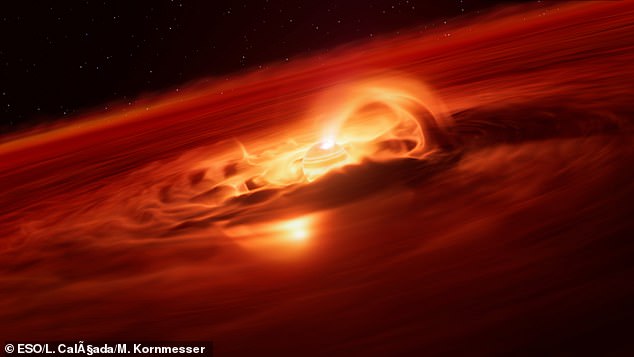A rogue planet 620 light-years from Earth has baffled scientists as it puts on a record-breaking ‘growth spurt’.
In a months-long feeding frenzy, the planet hoovered up six billion tonnes of gas and dust every second.
The distant world, officially known as Cha 1107-7626, is located in the Chamaeleon constellation and is what scientists call a ‘rogue planet’.
This means it is a free-floating mass which drifts through space by itself, rather than orbiting a star like Earth orbits the sun.
Embedded in a rotating spiral of gas and dust, the planet pulls in a constant stream of new matter to feed its growth, in a process called accretion.
However, while this was the fastest accretion burst ever recorded, the researchers believe that this is the planet’s ‘last trickle’ of growth.
Study co-author Dr Alexander Scholz, an astronomer from the University of St Andrews, told Daily Mail: ‘This rogue planet is pretty much finished with its growth.
‘The really strong growth spurts would have happened earlier, while the object was still enshrouded in dust and gas, invisible to us.’

Scientists have been baffled by a young rogue planet which has put on a record-breaking growth spurt, hoovering up six billion tonnes of gas and dust every second (artist’s impression)
Although Cha 1107-7626 is now between five and 10 times the size of Jupiter, the rogue planet is still in its infancy.
During this period of their existence, these lonely objects can sometimes begin extremely rapid periods of growth known as accretion bursts.
Most of these bursts occur at the earliest moments of a rogue planet’s formation, when it is still shrouded in dust that telescopes can’t penetrate.
Dr Scholz says: ‘When we can observe them, they are already close to the finished products. The really exciting early evolution happens when they are embedded in a thick cloud. ‘
However, using the European Southern Observatory’s Very Large Telescope, scientists were able to catch the rogue planet as it entered a particularly rapid growth spurt.
Over a period of a few weeks, the rogue planet’s accretion rate increased by almost eight times, reaching a peak in August and staying at that level for several months.
Lead researcher Dr Víctor Almendros-Abad, an astronomer at the National Institute for Astrophysics in Italy, says: ‘This is the strongest accretion episode ever recorded in a planetary-mass object.
‘People may think of planets as quiet and stable worlds, but with this discovery we see that planetary-mass objects freely floating in space can be exciting places.’

Located in the Chamaeleon constellation around 620 light-years from Earth, the planet known as Cha 1107-7626 is a ‘rogue planet’. This means it does not orbit any star. Pictured: an infrared image showing the planet’s location in the centre of frame
Scientists still aren’t exactly sure what causes such sudden and powerful bursts of accretion.
Some theories suggest that nearby companion objects might trigger a sort of avalanche in the accretion disc, while others propose that the burst might be caused by instabilities in the surrounding nebula.
This new study doesn’t settle that debate, but by looking at the light coming from the planet before and after the burst, the researchers were able to reveal new details about the accretion process.
Using the James Webb Space Telescope, Dr Almendros-Abad and his colleagues found that there was now water vapour in the disk around the planet that hadn’t been there before.
Likewise, the scientists were able to show that the planet’s magnetic field actually played a major role in funnelling material from the inner edge of the disc into the planet.
This is strikingly similar to how stars use their magnetic fields to feed on gases in the early stages of their lives.
Scientists had long thought that the rogue planets and stars might grow in similar ways.
For example, stars also grow through accretion bursts in which they gather most of their mass in short spurts, followed by long lulls.

Scientists believe that this kind of rogue planet might form in a very similar way to how stars are born, pulling in gas and dust to form a disc around itself. This discovery further ‘blurs the line’ between rogue planets and stars. Pictured: A visible light image of the planet’s location
But this new discovery further ‘blurs the line’ between rogue planets and stars.
This suggests that large gas giant planets might form in exactly the same way as stars, contracting clouds of dust and forming their own discs.
Some of the largest rogue planets might even form smaller planets of their own from the leftover material in the disc, creating miniature planetary systems without a sun.
Dr Amelia Bayo, an astronomer at the European Southern Observatory, says: ‘The idea that a planetary object can behave like a star is awe-inspiring and invites us to wonder what worlds beyond our own could be like during their nascent stages.’
This article was originally published by a www.dailymail.co.uk . Read the Original article here. .

